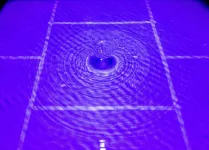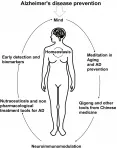(Press-News.org) The Milky Way is surrounded by dozens of dwarf galaxies that are thought to be relics of the very first galaxies in the universe. Among the most primitive of these galactic fossils is Tucana II -- an ultrafaint dwarf galaxy that is about 50 kiloparsecs, or 163,000 light years, from Earth.
Now MIT astrophysicists have detected stars at the edge of Tucana II, in a configuration that is surprisingly far from its center but nevertheless caught up in the tiny galaxy's gravitational pull. This is the first evidence that Tucana II hosts an extended dark matter halo -- a region of gravitationally bound matter that the researchers calculated to be three to five times more massive than scientists had estimated. This discovery of far-flung stars in an ancient dwarf galaxy implies that the very first galaxies in the universe were also likely extended and more massive than previously thought.
"Tucana II has a lot more mass than we thought, in order to bound these stars that are so far away," says MIT graduate student Anirudh Chiti. "This means that other relic first galaxies probably have these kinds of extended halos too."
The researchers also determined that the stars on the outskirts of Tucana II are more primitive than the stars at the galaxy's core. This is the first evidence of such a stellar imbalance in an ultrafaint dwarf galaxy.
The unique configuration suggests that the ancient galaxy may have been the product of one of the first mergers in the universe, between two infant galaxies -- one slightly less primitive than the other.
"We may be seeing the first signature of galactic cannibalism," says Anna Frebel, the Silverman Family Career Development Associate Professor of Physics at MIT. "One galaxy may have eaten one of its slightly smaller, more primitive neighbors, that then spilled all its stars into the outskirts."
Frebel, Chiti, and their colleagues have published their results today in Nature Astronomy.
Not-so-wimpy galaxies
Tucana II is one of the most primitive dwarf galaxies known, based on the metal content of its stars. Stars with low metal content likely formed very early on, when the universe was not yet producing heavy elements. In the case of Tucana II, astronomers had previously identified a handful of stars around the galaxy's core with such low metal content that the galaxy was deemed the most chemically primitive of the known ultrafaint dwarf galaxies.
Chiti and Frebel wondered whether the ancient galaxy might harbor other, even older stars, that might shed light on the formation of the universe's first galaxies. To test this idea, they obtained observations of Tucana II through the SkyMapper Telescope, an optical ground-based telescope in Australia that takes in wide views of the southern sky.
The team used an imaging filter on the telescope to spot primitive, metal-poor stars beyond the galaxy's core. The team ran an algorithm, developed by Chiti, through the filtered data to efficiently pick out stars with low metal content, including the previously identified stars at the center and nine new stars much further out from the galactic core.
"Ani's analysis shows a kinematic conection, that these far-out stars move in lockstep with the inner stars, like bathwater going down the drain," Frebel adds.
The results suggest that Tucana II must have an extended dark matter halo that is three to five times more massive than previously thought, in order for it to keep a gravitational hold on these far-off stars. Dark matter is a hypothetical type of matter that is thought to make up more than 85 percent of the universe. Every galaxy is thought to be held together by a local concentration, or halo, of dark matter.
"Without dark matter, galaxies would just fly apart," Chiti. says. "[Dark matter] is a crucial ingredient in making a galaxy and holding it together."
The team's results are the first evidence that an ultrafaint dwarf galaxy can harbor an extended dark matter halo.
"This probably also means that the earliest galaxies formed in much larger dark matter halos than previously thought," Frebel says. "We have thought that the first galaxies were the tiniest, wimpiest galaxies. But they actually may have been several times larger than we thought, and not so tiny after all."
"A cannibalistic history"
Chiti and Frebel followed up their initial results with observations of Tucana II taken by the Magellan Telescopes in Chile. With Magellan, the team focused in on the galaxy's metal-poor stars to derive their relative metallicities, and discovered the outer stars were three times more metal-poor, and therefore more primitive, than those at the center.
"This is the first time we've seen something that looks like a chemical difference beween the inner and outer stars in an ancient galaxy," Chiti says.
A likely explanation for the imbalance may be an early galactic merger, in which a small galaxy -- possibly among the first generation of galaxies to form in the universe -- swallowed another nearby galaxy. This galactic cannibalism occurs constantly throughout the universe today, but it was unclear whether early galaxies merged in a similar way.
"Tucana II will eventually be eaten by the Milky Way, no mercy," Frebel says. "And it turns out this ancient galaxy may have its own cannibalistic history."
The team plans to use their approach to observe other ultrafaint dwarf galaxies around the Milky Way, in hopes of discovering even older, farther-flung stars.
"There are likely many more systems, perhaps all of them, that have these stars blinking in their outskirts," Frebel says.
INFORMATION:
This research was supported in part by NASA and the National Science Foundation.
Written by Jennifer Chu, MIT News Office
Millions of patients suffering from neurological and mental disorders such as depression, addiction, and chronic pain are treatment-resistant. In fact, about 30% of all major depression patients do not respond at all to any medication or psychotherapy. Simply put, many traditional forms of treatment for these disorders may have reached their limit. Where do we go from here?
Research to be published in Nature Biomedical Engineering led by Maryam Shanechi, the Andrew and Erna Viterbi Early Career Chair in electrical and computer engineering at the USC Viterbi School of Engineering, ...
King Richard III's involvement in one of the most notorious and emotive mysteries in English history may be a step closer to being confirmed following a new study by Professor Tim Thornton of the University of Huddersfield.
Richard has long been held responsible of the murder of his nephews King Edward V and his brother, Richard, duke of York - dubbed 'the Princes in the Tower' - in a dispute about succession to the throne. The pair were held in the Tower of London, but disappeared from public view in 1483 with Richard taking the blame following his death two years later.
It has become of the most enduring unsolved mysteries of all, stoked by references in Shakespeare's play about the ...
Skoltech researchers helped their colleagues from Japan, Germany, the United States, and China study the crystal structure and optical properties of a new class of two-dimensional compounds, which can be used as effective visible-light-responsive photocatalysts for energy and chemical conversion. They used the Advanced Imaging Core Facility equipment for imaging and structural analysis. The paper was published in the Journal of the American Chemical Society.
One potential use of photocatalysts, so-called water splitting can help substitute climate-warming fossil fuels with more environmentally friendly hydrogen. For this process to work on ...
It has sometimes been suggested that humans use a tiny fraction of their brains. But, is this statement true? The authors of a study published on 20 January in the journal Nature Communications answer this question using neural records of mice subjected to visual stimuli.
This paper demonstrates, in the visual system of mice, the presence of a type of coordination of neural activity called differential correlations. A study by Rubén Moreno-Bote, a researcher at the Center for Brain and Cognition (CBC) and Serra Hunter research professor with the UPF Department of Information and Communication Technologies ...
Scientists have revealed new insights into the behaviour of black holes with research that demonstrates how a phenomenon called backreaction can be simulated.
The team from the University of Nottingham have used their simulation of a black hole, involving a specially designed water tank, for this latest research published in Physical Review Letters. This study is the first to demonstrate that the evolution of black holes resulting from the fields surrounding them can be simulated in a laboratory experiment.
The researchers used a water tank simulator consisting of a draining vortex, like the one that forms when you pull the plug in the bath. This mimics a black hole since a wave which comes too ...
Protein alteration in the family of lamins causes several diseases, known as laminopathies, such as progeria or precocious ageing. A study in which UB researchers have taken part states that alterations in the levels of one of these proteins, lamin B1, contribute to the degeneration of different brain neuronal populations in Huntington's disease. Caused by a mutation in the huntingtin gen, this pathology features involuntary movements, cognitive deficit and psychiatric disorders, and has no cure yet.
According to the study, published in the journal EMBO Molecular Medicine, these results open new therapeutic pathways for the treatment of this disease, since research shows pharmacological normalization of levels of lamin ...
As COVID-19 spread across the world, so did conspiracy theories and false information about the virus. This proliferation of misinformation--labeled an "infodemic" by the World Health Organization (WHO)--makes it difficult to identify trustworthy sources and can threaten public health by undermining confidence in science, governments, and public health recommendations.
The consequences of misinformation can be tragic: hundreds died and thousands were poisoned in Iran after consuming toxic methanol alcohol, falsely believing it could cure COVID-19.
In a new article in the Journal of Public ...
The COVID-19 pandemic is straining health systems across the country, especially intensive care units. New research from the U.S. Department of Veterans Affairs, Regenstrief Institute and Indiana University School of Medicine shows that people treated in the ICU for COVID-19 are twice as likely to die when the ICU capacity is strained by the number of COVID-19 patients.
"These results demonstrate that patients with COVID-19 are more likely to die if they are admitted to an ICU during times with peak COVID-19 caseload," said Dawn Bravata, M.D., first author of the study. "We know that strain on hospital ...
Amsterdam, December 29, 2020 - This new pioneering study by Prof. Ricardo Maccioni and coworkers of the International Center for Biomedicine, "New Frontiers in the prevention, diagnosis and treatment of Alzheimer´s disease" was published in the special issue of Latin American investigators of the Journal of Alzheimer's Disease(JAD). This supports a growing body of research on the Alzheimer's prevention value of an integrated approach using daily exercise, nutraceuticals, oriental practices such as QiGong along with meditation, and social life. These elements of a healthy style of life are supplemented with the use of reliable biomarkers for early detection of this disease that allows the detection of Alzheimer up to 20 years before ...
Chronic stress could be the prevailing condition of our time. In the short term, our jaws or stomachs may clench; in the long term, stress can lead to metabolic disease and speed up diseases of aging, as well as leading to more serious psychological disorders. The physical manifestations of stress originate in the brain, and they move along a so-called "stress axis" that ends in the adrenal glands. These glands then produce the hormone cortisol. When the stress axis is continually activated, changes occur in the cells and organs along the way, and the continual production of cortisol then substantially contribute the symptoms of chronic stress.
The stress response axis starts with the hypothalamus in the brain, ...



